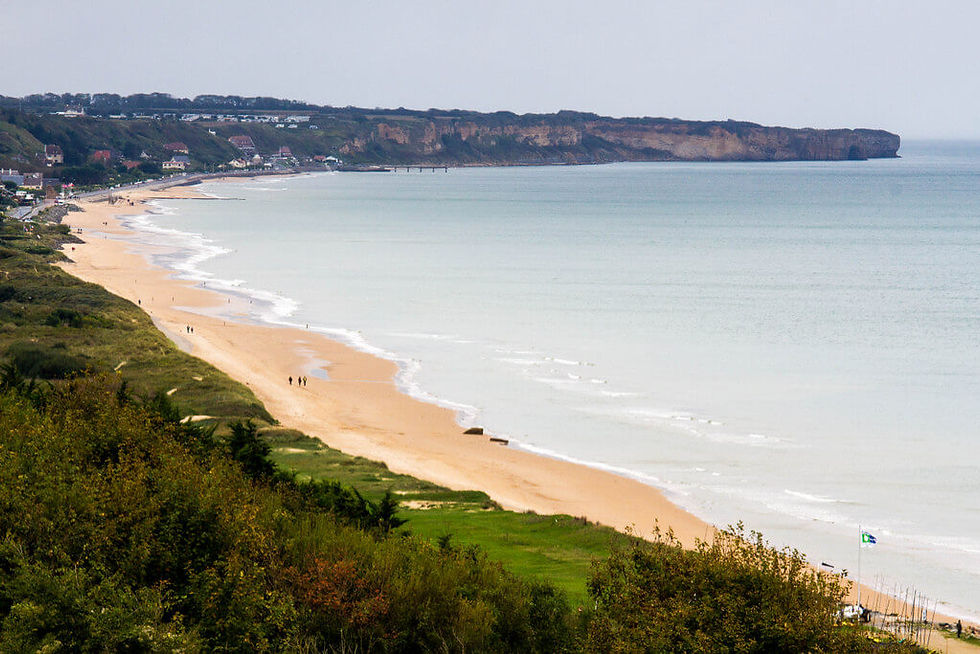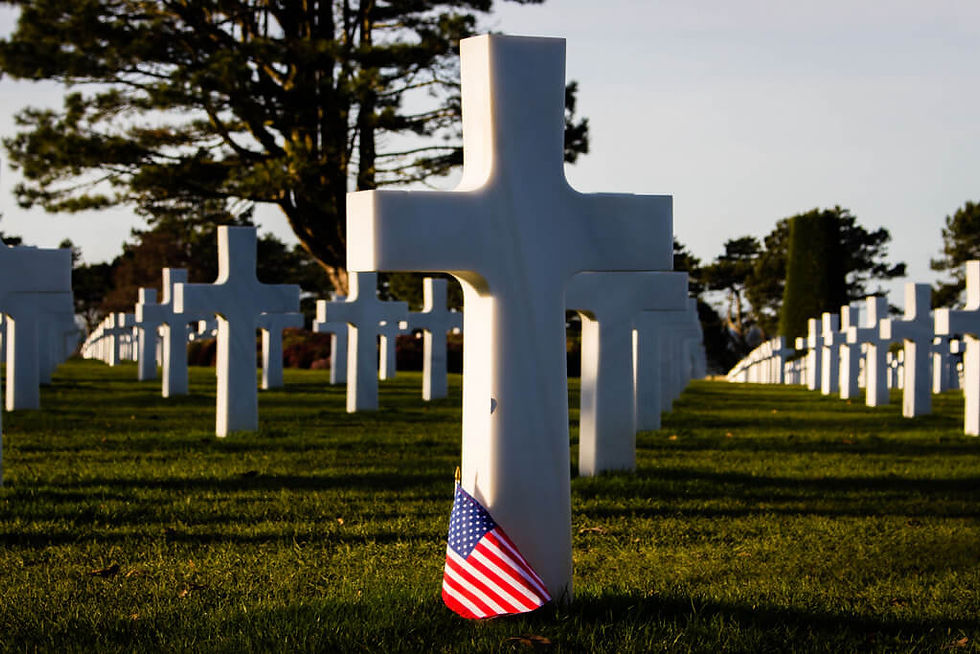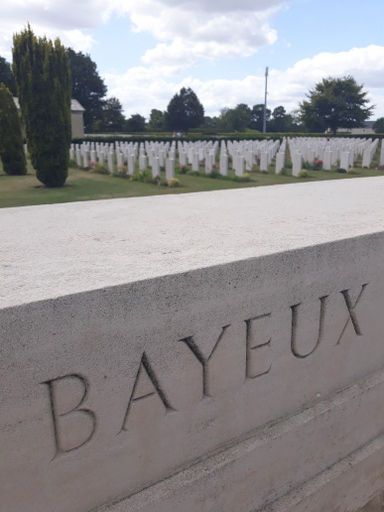The Longest Day - How much can you fit into a D-Day Tour?
- --Patrick Hilyer

- Mar 7, 2019
- 7 min read
Updated: Jul 26, 2021
Our must-see D-Day sites from Utah Beach to Pegasus Bridge

Many visitors to Normandy do it in just 8 or 9 hours. Some even travel from Paris and back again in one day. What's for sure is that you can't possible see everything relating to D-Day in that time. The road from the easternmost end of the landing beaches at Sword to the westernmost point at Utah beach is over 100km long. The route takes you past hundreds of the Atlantic Wall's bunkers and strongpoints, scores of sites of interest - villages, churches, cemeteries, ports and harbors - and dozens of museums and memorials. Some tour groups we work with spend a whole week touring the various sites associated with the 6th of June 1944 - what General Erwin Rommel called 'The Longest Day' (no, the title of the 1962 film wasn't coined by a Hollywood producer). So, just how much D-Day history can you experience on a 9-to-5 tour of the beaches?

This is a question many people ask. What can we see in a day? Well, quite a lot actually. With a good private guide you should have a truly memorable D-Day experience. You might not go to every site, visit every museum, but you will return to your hotel or bed-and-breakfast with a head full of memories - the sights and sounds, the facts and figures, and above all the emotions of a once-in-a-lifetime trip.
We've been organizing private guided tours for our guests since 2014 - the year of the 70th anniversary of D-Day. This year sees the 75th annual commemorations, and a program of incredible events in the towns and villages along the Normandy coast will draw in tens of thousands of visitors. The rest of this blog will give you a list of the 'must see' D-Day sites included in our tours. The 2019 D-Day Festival program is detailed in a previous blog post here. To book a D-Day Tour with us click here.

Utah Beach
A good starting point for visitors, Utah Beach is the furthest west of the D-Day landing sites. You can visit the memorials, the bunkers, climb aboard a landing craft (LCVP) and then walk down to the beach. This is the spot where the assault group of the 4th Infantry Division - carried 2,000 yards from their landing zone - came ashore with Brigadier General Theordore Roosevelt Jr. After he disembarked he told his battalion commanders, “We will start the war from right here!” Tides and winds had knocked them off course, but where they landed - La Madelaine - was less well defended than the pre-planned landing sectors. Of the 23,000 seaborne troops of VII Corps who landed on D-Day only 197 were killed, injured or captured. If time allows, you can visit the Utah Beach Landing Museum, watch a short but highly informative movie and view the impressive exhibits which include Major Dewhurst’s B26 Marauder ‘Dinah Might’, a DUKW amphibious truck and a restored Higgins Boat landing craft.

Sainte-Marie-du-Mont and Sainte-Mère-Eglise
From Utah Beach you take one of the five causeways which provided the troops with their only exits from the beach across the flooded fields, past the memorial to Major Richard Winters, Easy Company 506th Parachute Infantry Regiment and through Sainte-Marie-du-Mont – one of the first villages to be liberated on D-Day. Keen-eyed viewers of the HBO series Band of Brothers will recognize the WW1 war memorial in the town square.
Next comes Sainte-Mère-Eglise, a place made famous by the movie The Longest Day, where a manikin of paratrooper John Steele still swings from its chute lines atop the spire of the town’s 12th-century church. A visit to the church to see the beautiful stained-glass windows which commemorate the town’s Airborne liberators is followed by a stroll in the town square – the scene of one of D-Day’s first assaults on the night of June 5-6 1944. At this point you can enjoy a quick, simple lunch break in one of the many casual eateries in the town and visit the Airborne Museum whose fascinating exhibits include a Waco glider and an entire C47 Dakota transport plane.
After lunch, time allowing, you can visit the village church of Angoville-au-Plain, where two young army medics, Robert Wright and Ken Moore, valiantly treated over 80 casualties in the heat of battle.

Pointe du Hoc
Next you travel the long road which links the Utah/Airborne sectors to Omaha sector, stopping en-route at the site of one of D-Day’s hardest fought (and held) objectives: Pointe du Hoc. You will learn about the 2nd Rangers Battalion who, led by Lieutenant Colonel James Earl Rudder, scaled the seemingly insurmountable cliffs to capture the gun battery complex at the western end of Omaha beach. You can see the gun emplacement 'casemates' and visit the bunkers strewn across the almost lunar landscape of shell craters made by the aerial and sea bombardments. The 2nd Rangers memorial is situated right on the point above the observation bunker which is open to visitors.

Omaha Beach
From Pointe du Hoc it’s a short, pleasant drive to the villages that run the length of Omaha Beach – Vierville-sur-Mer, Saint-Laurent-sur-Mer and Colleville-sur-Mer. You can visit the Omaha beach memorials and set foot on the beach that claimed more allied casualties than any other on D-Day. Of the 34,000 men of V Corps who landed on Omaha's 6 miles of sand, over 4,000 were casualties, and 1,465 paid the ultimate sacrifice.
Next you can follow the ‘draws’ - the heavily defended steep-sided gullies which provided the troops with the only exits from the beach - to arrive at the American Cemetery above the beach.

The American Cemetery
The North American Cemetery at Colleville-sur-Mer covers 172 acres of beautifully tended cliff-top lawns above the vast expanse of Omaha beach. You can visit the memorial, the wall dedicated to over 1,500 missing soldiers, and the graves themselves – 9,388 crosses and stars of David. Your guide can help you to locate the grave of a relative, or you can pay your respects to some of the cemetery's other heroes, among them Theodore Roosevelt Jr, his brother Quentin, the brothers Preston and Robert Niland (who inspired the story of Saving Private Ryan), General Leslie J McNair, and Medal of Honor recipients Lieutenant Jimmie Watters Monteith Jr and Technical Sergeant Frank D. Peregory. Plan to be at the cemetery for Taps and the solemn ceremony of the lowering of the flags (4:00pm during the winter period / 5:00pm during the summer period).

Longues-Sur-Mer
Leaving the US Sector behind and crossing into the British & Canadian sector, a little further east you arrive at the gun battery at Longues-sur-Mer. On D-Day, four 152mm guns in concrete casemates fired on targets at sea and on the beaches. The British cruisers HMS Ajax and HMS Argonaut put the battery out of action, but you can see three of the original guns that are still in position. If you have time you should visit the observation bunker which is in remarkably good order seventy-five years after the battle!

Arromanches
Continuing eastwards, you reach the seaside village of Arromanches-les-Bains. The gently curving bay, sheltered on two sides by cliffs, was the ideal location for the Allies’ artificial harbour, codenamed Mulberry. You can view the remains of the harbour from the cliffs and descend to the beach where several of the giant caissons used to support the floating piers can still be viewed. On June 15 1944 the harbour began operating and by the end of the war 2.5 million troops, half a million vehicles and 4 million tonnes of supplies had been brought ashore. The village itself is charming and there are several good cafés and restaurants.

Gold Beach
Gold beach, just north of the cathedral town of Bayeux, was the responsibility of the British XXX Corps under Lieutenant General Bucknall. 25,000 men disembarked on Gold’s five miles of sand but the German defense resulted in over a thousand British casualties. One man’s courage – Sergeant Stan Hollis – earned him the only Victoria Cross awarded on D-Day. You can visit the tram stop on the beach (misidentified by allied reconnaissance as an enemy pillbox) where Hollis came ashore, the Mount Fleury Battery which he neutralized almost single-handedly, and the village of Crépon where a memorial to his Brigade, The Green Howards, now stands.

Juno Beach
From Gold beach you arrive at Juno: six miles of beach from Graye-sur-Mer to Langrune-sur-Mer. Here Major General Keller’s Canadian 3rd Infantry came ashore. 21,000 troops landed but several companies – notably the Royal Winnipeg Rifles and The Queen’s Own Rifles of Canada – suffered heavy casualties. Resistance from the German 716th Infantry Division and elements of 21st Panzer resulted in nearly 1,000 troops killed, wounded or captured. You can see Canada House in Bernières-sur-Mer (one of the first private residences to be liberated on D-Day), the Juno Beach Centre and the charming marina at Courseulles-sur-Mer – the port where Winston Churchill first disembarked on June 12, 1944.

Sword Beach and Pegasus Bridge
You arrive, at last, at the very eastern end of the landing beaches at Ouistreham. Visit Lord Lovat’s statue, the 70th Anniversary Sword Beach Memorial, and the Kieffer Monument (a tribute to the French commandos). By the end of D-Day, over 28,000 men had come ashore at Sword for 683 casualties. The monolithic concrete bunker here was the objective of No.4 Commando troops supported by the Free French Fusiliers Marins. You can visit the multi-storied building which is now a museum dedicated to the Atlantic Wall.
Finally, you can complete your tour at the site of the British 6th Airborne Division’s textbook capture of the Caen canal and Orne bridges in the early hours of D-Day – Operation Deadstick. In the museum you can step across the original bascule bridge, renamed Pegasus after the paratroopers’ flying horse insignia. There’s a short and informative film introduced by HRH Prince Charles who inaugurated the memorial in 2000, and some fascinating exhibits including a full-scale replica of a Horsa Glider.
Wow! What an itinerary! To do it all in one day would surely be 'the longest day'... It might be advisable to set aside two days for all ten. And if you need any help or advice, or if you would like to book one of our private guided tours, please get in touch!




Comments